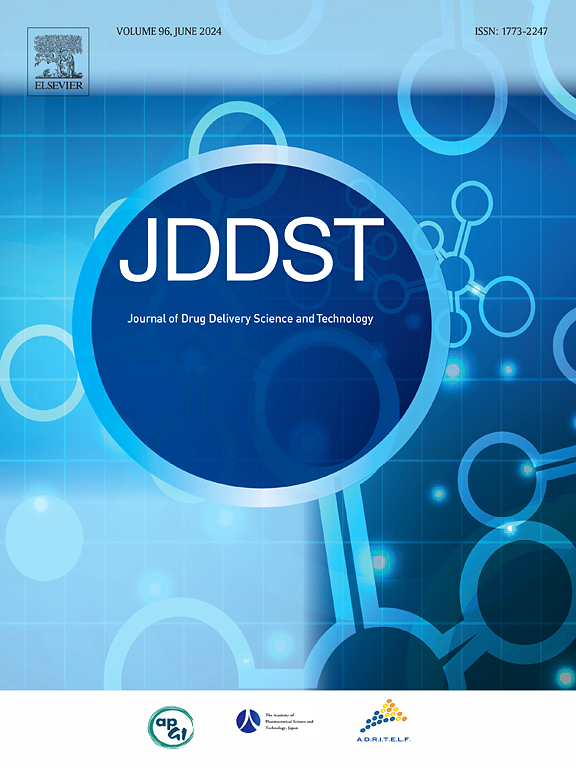IF 4.5
3区 医学
Q1 PHARMACOLOGY & PHARMACY
Journal of Drug Delivery Science and Technology
Pub Date : 2025-03-31
DOI:10.1016/j.jddst.2025.106870
引用次数: 0
摘要
达沙替尼对三阴性乳腺癌具有令人鼓舞的活性。然而,其微小的口服生物利用度(约 34%)是个问题。这种最低生物利用度与溶解性差、肠道渗透性低和前系统代谢有关。我们的目的是开发和评估用于提高溶解度和渗透性的 SEDD。肉桂油和吐温 80 与乙醇(F2)或 PEG 200(F3)一起用作主要成分(F1)。复溶后的 SEDDS 为纳米级。SEDDS 加快了达沙替尼的溶解,而 F2 则更胜一筹。 兔子从水溶液中的原位肠道吸收验证了 P-gp 外流的不完全吸收。十二指肠、空肠-回肠和结肠吸收 95% 所需的长度(L95 %)分别为 305.76 厘米、388.38 厘米和 224.85 厘米。将达沙替尼作为 F2 重组后的纳米乳剂给药,可促进肠道吸收,使相同段落的 L95 % 分别降至 104.54、155.84 和 58.91。体内抗肿瘤活性证明,由 F1 和 F2 复配而成的纳米乳剂与水分散液相比更具优势,其中 F2 的前景更为广阔。该研究引入了肉桂油 SEDDS,以提高达沙替尼的溶解度、肠道渗透性和体内疗效。本文章由计算机程序翻译,如有差异,请以英文原文为准。

Nanoemulsion for enhanced absorption and anti-tumor activity of dasatinib
Dasatinib showed encouraging activity on triple-negative breast cancer. However, its minute oral bioavailability (about 34 %) is problematic. This minimum bioavailability is related to poor dissolution, low intestinal permeation and pre-systemic metabolism. The aim was to develop and evaluate SEDD for dissolution and permeability enhancement. Cinnamon oil with Tween 80 were utilized as principal composition (F1) with ethanol (F2) or PEG 200 (F3). The developed SEDDS was in the nanoscale after reconstitution. SEDDS hastened dasatinib dissolution with superiority of F2. In-situ rabbit intestinal absorption from aqueous solution verified the incomplete absorption with input from P-gp efflux. This was shown from the length needed for 95 % absorption (L95 %) which was 305.76, 388.38 and 224.85 cm for duodenum, jejuno-ileum and colon, respectively. Delivering dasatinib as nanoemulsion resulting from reconstitution of F2, enhanced intestinal absorption to reduce L95 % to 104.54, 155.84 and 58.91 in the same segments, respectively. The in vivo antitumor activity proved the superiority of nanoemulsion resulting from F1 and F2 compared with aqueous dispersion with F2 being more promising. The research introduced cinnamon oil SEDDS for augmented dasatinib dissolution, intestinal permeation and subsequently in vivo efficacy.
求助全文
通过发布文献求助,成功后即可免费获取论文全文。
去求助
来源期刊
CiteScore
8.00
自引率
8.00%
发文量
879
审稿时长
94 days
期刊介绍:
The Journal of Drug Delivery Science and Technology is an international journal devoted to drug delivery and pharmaceutical technology. The journal covers all innovative aspects of all pharmaceutical dosage forms and the most advanced research on controlled release, bioavailability and drug absorption, nanomedicines, gene delivery, tissue engineering, etc. Hot topics, related to manufacturing processes and quality control, are also welcomed.

 求助内容:
求助内容: 应助结果提醒方式:
应助结果提醒方式:


